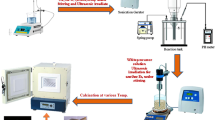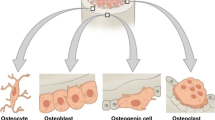Abstract
Silica gel has been reported to induce apatite nucleation on its surface in vitro and it can act as a stimulant that induces formation of chemical apatite (Ca-P) layers on the surfaces of bioactive glass-ceramics. In this study, apatite formation in response to and the bone-bonding behavior of solica gels implanted in the tibiae of mature rabbits were studied. Implants were made from three silica gels treated at 400, 800, and 1000°C, and the effects of such heat treatment on the above parameters were investigated. The silica gel was made by hydrolysis and polycondensation of tetraethoxysilane in aqueous solution containing polyethylene glycol. Rectangular implants (15 mm × 10 mm × 2 mm) of each heat-treated silica gel were implanted into both tibial bones of mature male rabbits, which were killed 4 or 8 weeks after implantation, and the tibiae containing the implants were dissected out. The bone-implant interfaces were investigated using Giemsa surface staining, contact microradiography, scanning electron microscopy-electron probe microanalysis, and X-ray diffraction. Histologically, no bonding of bone to any of the silica gels was observed at any time postimplantation. Soft tissue was observed at the bone-silica gel interface, but there were no giant foreign body or inflammatory cells. A Ca-P-rich layer was observed only on small areas of the surfaces of the silica gels treated at 400 and 800°C 4 and 8 weeks after implantation. X-Ray diffraction analysis confirmed the presence of hydroxyapatite in these Ca-P-rich layers. At no time after implantation was a Ca-P-rich layer observed on the surface of silica gel treated at 1000°C. It is thought that a special type of silanol group, which forms on silica gel treated below 800°C, is responsible for the apatite nucleation. A Ca-P layer does not always form reliably on the surfaces of silica gels.
Similar content being viewed by others
References
Kokubo T, Shigematsu M, Nagashima Y, Tashiro M, Nakamura T, Yamamuro T, Higashi S (1982) Apatite-and wollastonite-containing glass-ceramic for prosthetic application. Bull Inst Chem Res Kyoto Univ 60:260–268
Nakamura T, Yamamuro T, Higashi S, Kokubo T, Itoo S (1985) A new glass-ceramic for bone replacement: evaluation of its bonding ability to bone tissue. J Biomed Mater Res 19:685–698
Kitsugi T, Yamamuro T, Nakamura T, Higashi S, Kakutani Y, Hyakuna K, Ito S, Kokubo T, Takagi M, Shibuya T (1986) Bone bonding behavior of three kinds of apatite-containing glass-ceramics. J Biomed Mater Res 20:1295–1307
Kitsugi T, Yamamuro T, Nakamura T, Kokubo T, Shibuya T, Takagi M (1987) SEM-EPMA observation of three types of apatite-containing glass-ceramics implanted in bone: the variance of a Ca-P rich layer. J Biomed Mater Res 21:1255–1271
Kitsugi T, Yamamuro T, Nakamura T, Oka M, Kokubo T (1993) Influence of disodium (1-hydroxythylidene) diphosphonate on bonding between glass-ceramics containing apatite and wollastonite and mature male rabbit bone. Calcif Tissue Int 52:378–385
Kokubo T (1990) Surface chemistry of bioactive glass-ceramics. J Non-crystalline Solids 120:138–151
Kokubo T, Kushitani H, Sakka S, Kitsugi T, Yamamuro T (1990) Solutions able to reproduce in vivo surface-structure changes in bioactive glass-ceramic A-W3. J Biomed Mater Res 24:721–734
Kokubo T, Ito S, Huang ZT, Hayashi T, Sakka S, Kitsugi T, Yamamuro T (1990) Ca, P-rich layer formed on high-strength bioactive glass-ceramic A-W. J Biomed Mater Res 24:331–343
Pereira MM, Clark AE, Hench LL (1994) Calcium phosphate formation on sol-gel-derived bioactive glasses in vitro. J Biomed Mater Res 28:693–698
Li P, Ohtsuki C, Kokubo T, Nakanishi K, Soga N, Nakamura T, Yamamuro T (1993) Process of formation of bone-like apatite layer on silica gel. J Mater Sci: Mater Med 4:127–131
Li P, Ohtsuki C, Kokubo T, Nakanishi K, Soga N, Nakamura T, Yamamuro T (1992) Apatite formation induced by silica gel in a simulated body fluid. J Am Ceram Soc 75:2094–2097
Li P, Otsuki C, Kokubo T, Nakanishi K, Soga N, Nakamura T, Yamamuro T (1993) Effects of ions in aqueous media on hydroxyapatite induction by silica gel and its relevance to bioactivity of bioactive glasses and glass-ceramics. J Appl Biomaterials 4:221–229
Li P, Ohtsuki C, Kokubo T, Nakanishi K, Soga N, de Groot K (1994) The role of hydrated silica, titania, and alumina in inducing apatite on implants. J Biomed Mater Res 28:7–15
Gross UM, Strunz V (1977) Surface staining of sawed sections of undecalcified bone containing alloplastic implants. Stain Technol 52:217–219
Carlisl EM (1970) Silicon: a possible factor in bone calcification. Science 167:279–280
Landis WJ, Lee DD, Brenna JT, Chandra S, Morrison GH (1986) Detection and localization of silicon and associated elements in vertebrate bone tissue by imaging ion microscopy. Calcif Tissue Int 38:52–59
Nagase M, Abe Y, Chigira M, Udagawa E (1981) Toxicology and biocompatibility of bioglasses. J Biomed Mater Res 15:805–817
Kangasniemi IMO, Vahatalo K, Happonen R-P, Yli-Urpo A, de Groot K (1994) In vivo reactions of Ca, P particle containing surface reactive glasses. J Biomed Mater Res 28:993–1002
Kawanabe K, Yamamuro T, Nakamura T, Kotani S (1991) Effects of injecting massive amounts of bioactive ceramics in mice. J Biomed Mater Res 25:117–128
West JH, Hench LL (1991) Reaction kinetics of bioactive ceramics, part V: molecular orbital modeling of bioactive glass surface reactions. pp. 75–86 In: Yamamuro T, Kokubo T, Nakamura T (eds) Bioceramics, vol 5. Kobunshi Kankokai. Kyoto
Kitsugi T, Yamamuro T, Nakamura T, Kokubo T (1989) Bonding behavior of MgO-CaO-SiO2-P2O5-CaF2 glass (mother glass of A.W-glass ceramics). J Biomed Mater Res 23:631–648
Hench LL, Ethridge EC (1982) Biomaterials: an interfacial approach. In: Biophysics and bioengineerings series, vol 4. Academic Press, New York, pp 62–86, 126–148
Author information
Authors and Affiliations
Additional information
Deceased
Rights and permissions
About this article
Cite this article
Kitsugi, T., Nakamura, T., Oka, M. et al. Bone-bonding behavior of three heat-treated silica gels implanted in mature rabbit bone. Calcif Tissue Int 57, 155–160 (1995). https://doi.org/10.1007/BF00298437
Received:
Accepted:
Issue Date:
DOI: https://doi.org/10.1007/BF00298437




